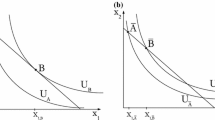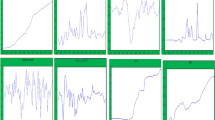Abstract
The cross-section distribution of U.S. import prices exhibits some of the fat-tailed characteristics that are well documented for the cross-section distribution of U.S. consumer prices. This suggests that limited-influence estimators of core import price inflation might outperform headline or traditional measures of core import price inflation. We examine whether limited influence estimators of core import price inflation help forecast overall import price inflation. They do not. However, limited influence estimators of core import price inflation do seem to have some predictive power for headline consumer price inflation in the medium term.

Similar content being viewed by others
Notes
See for example Charles Bean’s remarks at the Jackson Hole symposium in 2006, and specifically his observation that “While the Sino-Indian development miracle probably has some way to run, the near-tripling of oil prices over the past couple of years, and the rise in commodity prices more generally, is surely itself in large part a reflection of the rapid industrialization of China and the other emerging economies. The fact that the rise in oil prices is the flip side of the globalization shock to me renders highly suspect the practice of focusing on measures of core inflation that strip out energy prices while retaining the falling goods prices”. (Bean 2006, pp. 307–308).
See for example Gordon (2011).
The monthly report also includes import prices classified by end use category and by NAICS.
Recall that Bryan and Cecchetti (1994) worked with 36 component series of the CPI.
See Appendix for steps of calculating trimmed mean measures of inflation.
In addition to the headline (“All commodities”) import price index reported each month, the U.S. Department of Labor also reports a number of core import price indexes, specifically for “All commodities excluding food and fuels”, “All commodities excluding petroleum”, “All commodities excluding computers/semiconductors/petrol”, “All commodities excluding fuels”, and “All commodities excluding computers/semiconductors/fuels”. The rationale for these measures of core import price inflation is much the same as that for the traditional exclusion type measures of core CPI or PPI inflation, namely that movements in the prices of certain categories of commodities or goods are excluded from months that they may have a large effect on the headline number and might not be indicative of underlying trends.
We pick an estimation period of nine years as this generally captures a full business cycle, and is analogous to the length of time used in D’Agostino and Surico (2009). Twelve-year and a five-year estimation periods were also considered, and the results were generally unchanged.
Selection of optimal lag structure for the benchmark model is robust to using the Akaike information criterion.
References
Bean C (2006) Commentary: impact of globalization on monetary policy. In: Federal reserve bank of Kansas City. The new economic geography: effects and policy implications. Kansas City: Federal Reserve Bank of Kansas City
Bryan MF, Cecchetti SG (1994) Measuring core inflation. In: Mankiw NG (ed) Monetary policy. University of Chicago Press, Chicago
Bryan MF, Pike CJ (1991) Median price changes: an alternative approach to measuring current monetary inflation. Federal Reserve Bank of Cleveland, Economic Commentary
D’Agostino A, Surico P (2009) Does global liquidity help forecast U.S. inflation? J Money, Credit Bank 41:479–489
Dolmas J (2005) Trimmed mean PCE inflation. Federal Reserve Bank of Dallas Research Department Working Paper 0506
Gordon RJ (2011) The history of the Phillips Curve: consensus and bifurcation. Economica 78:10–50
Martínez-García E, Wynne MA (2010) The global slack hypothesis. Federal Reserve Bank of Dallas, Staff Papers, number 10
Martínez-García E, Wynne MA (2012) Global slack as a determinant of U.S. inflation. Federal Reserve Bank of Dallas, Globalization and Monetary Policy Institute Working Paper no. 123
Phillips AW (1958) The relationship between unemployment and the rate of change of money wages in the United Kingdom 1861–1957. Economica 25(100):283–299
Roger S (1997) A robust measure of core inflation in New Zealand 1949–96. Discussion Paper G97/7, Reserve Bank of New Zealand
Stock JH, Watson MW (1999) Forecasting inflation. J Monet Econ 44:293–335
Vega JL, Wynne MA (2003) A first assessment of some measures of core inflation for the euro area. Ger Econ Rev 4:269–306
Wynne MA, Solomon GR (2007) Obstacles to measuring global output gaps. Federal Reserve Bank of Dallas. Econ Lett 2(3):2–7
Author information
Authors and Affiliations
Corresponding author
Additional information
The views expressed in this paper are those of the authors and do not necessarily reflect the views of the Federal Reserve Bank of Dallas or the Federal Reserve System. The authors would like to thank two anonymous referees for helpful comments and suggestions.
Appendix: Computing Trimmed Mean Import Price Inflation
Appendix: Computing Trimmed Mean Import Price Inflation
Each month’s trimmed mean import price inflation rate is calculated using the following steps.
-
1.
Compute the monthly percent change (without annualization) in each component import price index.
-
2.
Sort the percent changes in price from smallest to largest, and sort the relative importance weights for each component along with the price changes. The ordered inflation rates and weights are denoted, respectively, π i and w i, i = 1, 2, 3....,n.
-
3.
Form the cumulative sum of the sorted relative importance weights for each ordered price change i. For example, the cumulative weight associated with π 4,the fourth-ranked price change, equals w 1 + w 2 + w 3 + w 4.
-
4.
Exclude those percent changes in price for which the cumulative weight is either equal or more than α, the percent you would like to trim to compute a (α)-trimmed mean inflation, i.e. let \(i_{t} (\alpha) = \min \left\{ I:\sum\limits_{i=1}^{I}w_{i,t} \geq\alpha\right\} \) for α ∈ [0, 100]
-
5.
A trimmed mean import price inflation (α, β) that drops α % of the weight from the left tail of each month’s distribution and β % of the weight from the right tail of each month’s distribution is computed as \(\pi_{i}^{(\alpha,\beta)}=\frac{1}{100-\alpha-\beta} \sum\limits_{i=i_{t} (\alpha)}^{i_{t}(100-\beta)}w_{i,t}\pi_{i,t}\) for each date t
Below is an example of the computation of trimmed mean inflation measures. The table lists sample inflation data for six import price components for month t.
Import price components
A
B
C
D
E
F
m/m % import price inflation ordered from smallest to largest
1.25
1.80
2.50
3.20
3.60
4.50
Corresponding weights in import price index
0.05
0.04
0.25
0.38
0.18
0.10
Cumulative weights
0.05
0.09
0.34
0.72
0.90
1.00
To compute a trimmed mean inflation that truncates 10 % on each side, start by eliminating price changes whose cumulative weights fall outside the 0.1 and 0.9 range, i.e. only consider the price changes that are in the center of the price distribution after trimming 10 % from both left and right tail of the distribution. Product A, with the smallest price change and with a weight of 0.05 is eliminated. Product B is also eliminated because its cumulative weight is within than the 0.1 needed to be trimmed. Products C, D and E are retained as their cumulative weights fall within the 0.1 and 0.9 range. Product F is eliminated as its weight is exactly 0.1, the percent to be trimmed from the right tail of the import price distribution.
The new weighted average is computed using price changes of products C, D, and E i.e. (2.50 × 0.25) + (3.20 × 0.38) + (3.60 × 0.18) = 2.489. This average is normalized by dividing by the sum of the remaining weights (0.25 + 0.38 + 0.18) = 0.81
Therefore, the weighted average (a 10 % trimmed mean measure) for month t is \(\frac{2.489}{0.81}=3.07\)
Rights and permissions
About this article
Cite this article
Koech, J., Wynne, M.A. Core Import Price Inflation in the United States. Open Econ Rev 24, 717–730 (2013). https://doi.org/10.1007/s11079-012-9264-2
Published:
Issue Date:
DOI: https://doi.org/10.1007/s11079-012-9264-2
Keywords
- Inflation forecasting
- Trimmed mean inflation
- Limited influence estimators
- Core import prices
- Core inflation




